Guide to Strategic Giving
Introduction
Many donors “panic-give” before an election, “rage-give” based on the news cycle, or “impulse-give” to glitzy candidates with big coffers, slim chances, and clever emails.
Fortunately, Movement Voter PAC exists as a “one-stop shop” for political donors who want to give in a more strategic, effective, streamlined way for maximum impact.
With year-round investment in local voter organizations, we can win elections, transform policy, and build political power that grows each year.
This short guide covers:
Read offline:
Part 1: Why Year-Round Giving?
“You can’t plant daffodils in April and expect daffodils in April.” — Zakiya Lord, MVP Regional Philanthropic Director
1) Year-Round Money Yields More Votes.
Smart political philanthropy follows the same core principle as sound financial investment: Compound interest. The earlier the investment, the greater the return.
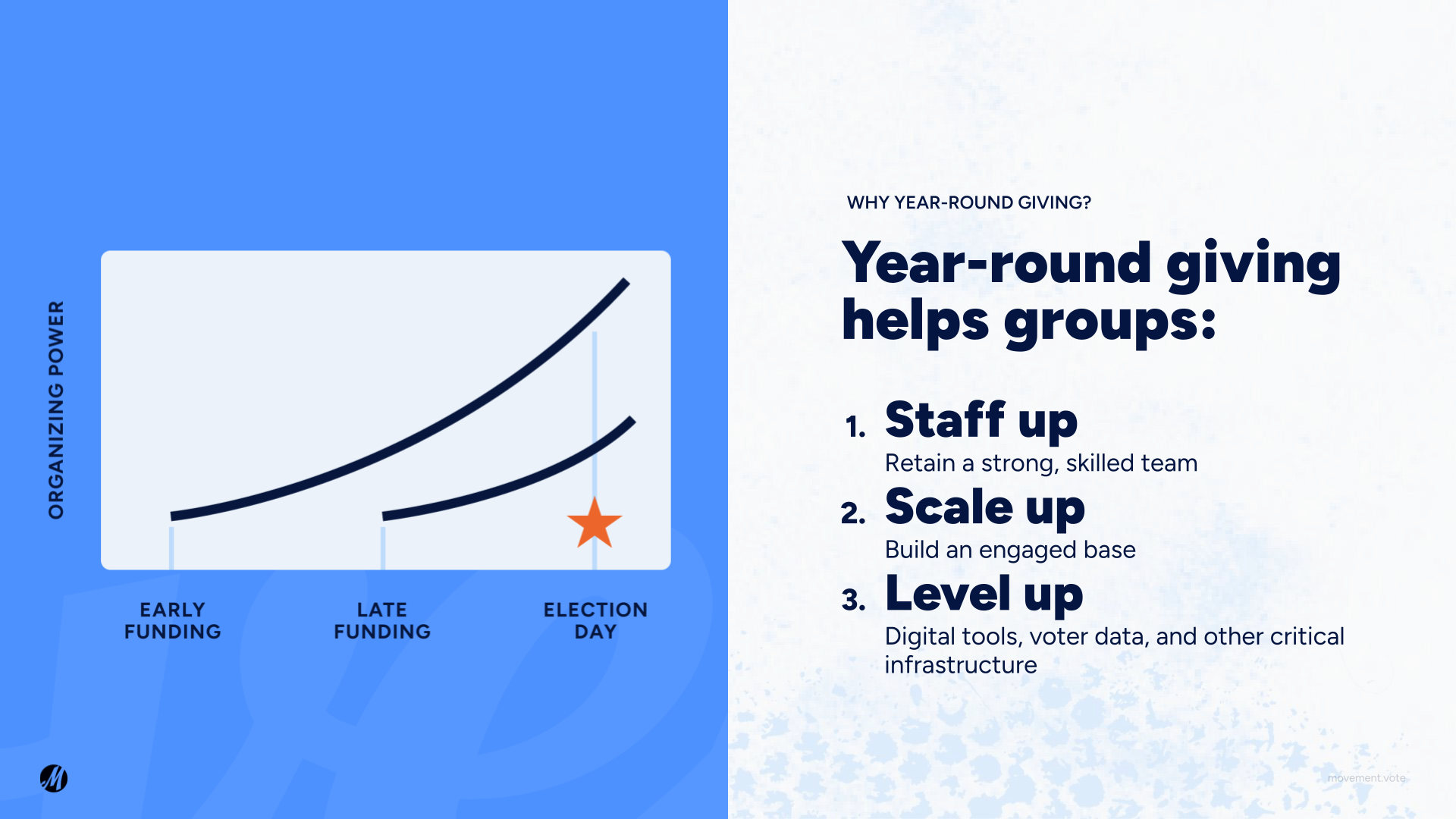
Year-round money helps voter engagement groups staff up, scale up, and level up, so they can maximize voter turnout.
Year-round money helps organizations:
- Staff up and reap the ongoing benefits of a skilled, effective, experienced team vs. scrambling to hire short-term workers each election.
- Scale up by creating repeatable structures and strategies that allow large numbers of volunteers to participate, become leaders, and recruit others.
- Level up by putting in place critical organizational infrastructure, from finance to development, legal, communications, and voter-outreach systems.
Year-round money means on-the-ground power that grows.
Year-round money funds year-round organizing, which means more voter registrations and education, higher (and earlier) voter turnout, and better efforts to count every vote and to ensure fair results.
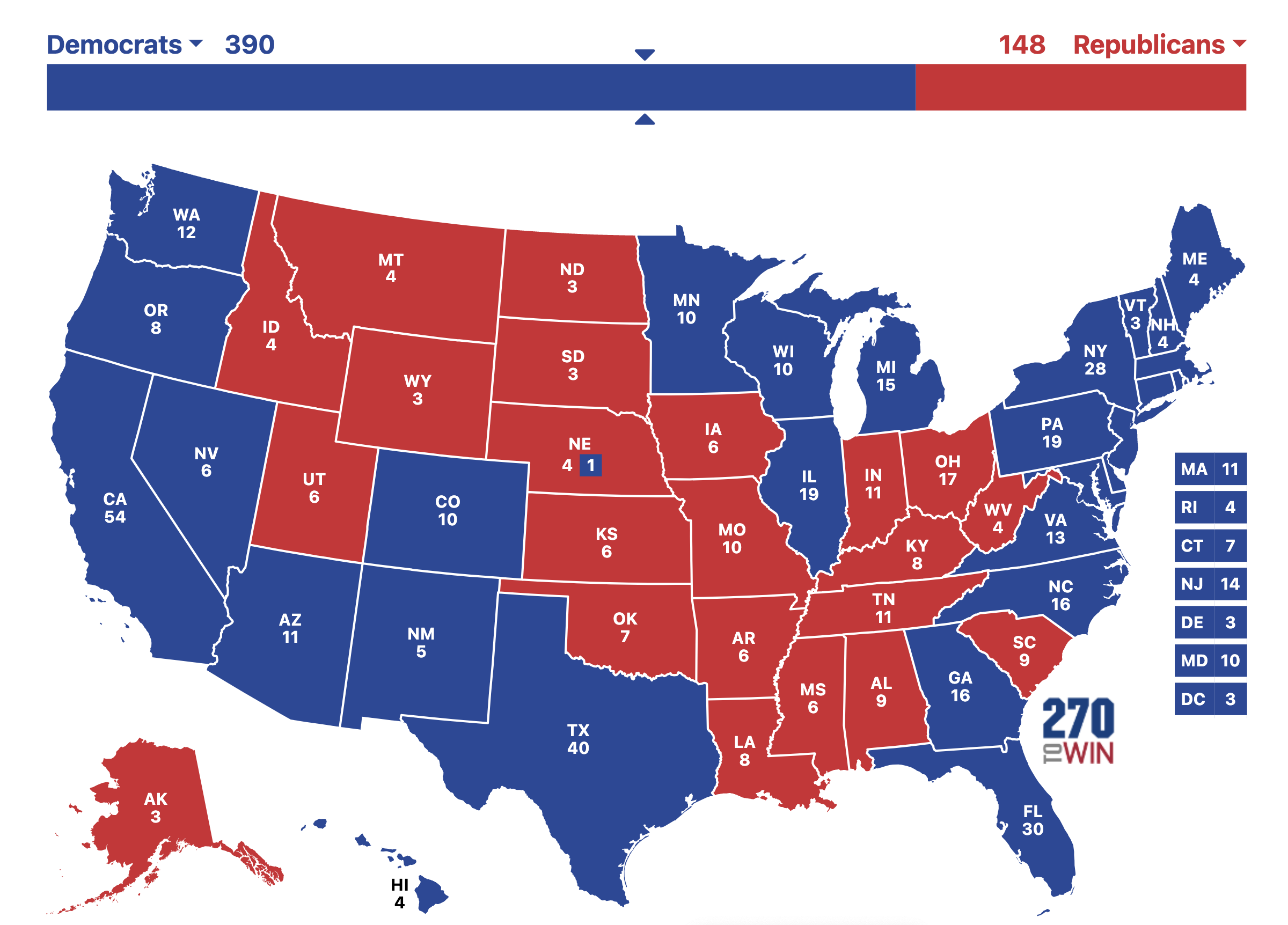
This is not a real electoral college map (yet) – but it could be if we stay in this for the long haul.
2) Year-Round Investment Expands the Map.
What if we could win durable majorities by decisive margins?
If we want electoral results in states and districts that are currently considered out of reach, we need to invest over multiple election cycles, not just every four years.
From “Boom and Bust” to “Build and Win” funding
When donors give sporadically, long-term organizing suffers. For example, the year after a presidential race, one group saw its budget drop 80% — from $5 million to just $1 million. When we give organizations true financial stability, they can harness momentum and build on gains made, leading to more ambitious plans and greater electoral wins.
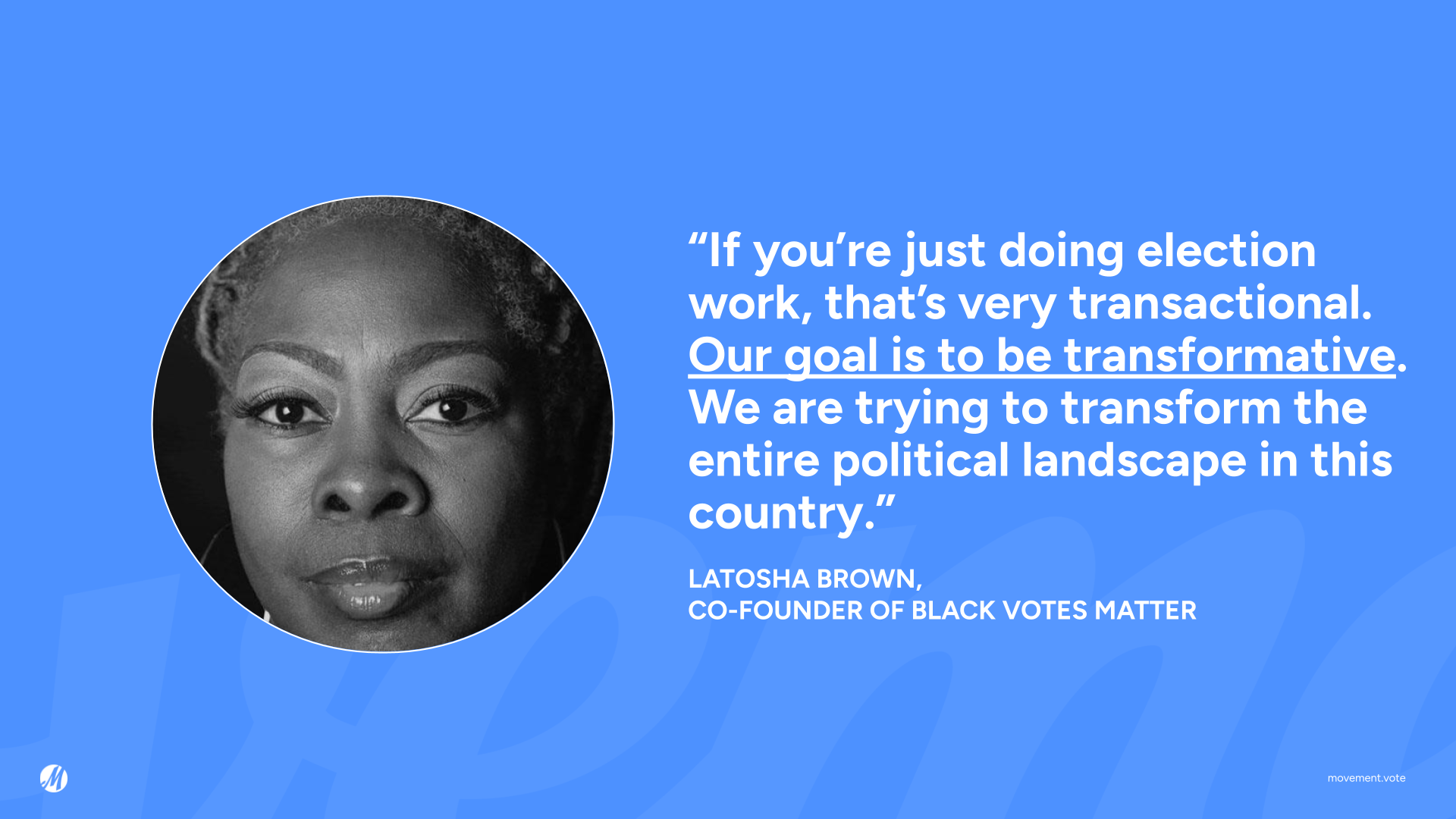
3) The Goal is Transformation, Not Transaction.
Elections are inflection points, not the endpoint.
Ultimately, political giving is about creating a nation where everyone can thrive. Elections are a means to an end. They set the conditions under which we can make progress.
“What I want to do is turn a million dollars of giving into a billion dollars of social change. Changing laws, norms, and policy is the only way that you can do that.”
— Nick Hanauer, venture capitalist and founder of Civic Ventures
Long-term change takes long-term investment.
In the long run, success looks like:
-
Durable governing majorities at every level of government.
-
Significant culture shifts fueled by locally-rooted, broad-based social movements.
-
Relentless public pressure for progressive policies, sustained by grassroots groups.
-
Transformative policy change by elected officials working in close “co-governance” with robust, year-round local organizations.
“It is the movement of public opinion, and how this change is embedded in such pillars of society over time, that leads politicians to evolve in their thinking.”
— Mark Engler and Paul Engler, Waging Nonviolence
How do we achieve this? Year-round investment in year-round local organizing.
We know this works because we’re proving it in the states.
- In Minnesota, MVP partners helped win a trifecta in 2022 and enacted some of the most sweeping state-level policy changes in recent years. But this progress didn’t come out of nowhere – it was the result of over a decade of strategic organizing and base-building, much of which was led by MVP partners working together around a shared analysis, strategy, and vision. This sustained organizing created the conditions for co-governance — when elected officials work hand-in-hand with close counterparts in civil society to enact a shared agenda.
- In Michigan, MVP partners helped win the first Democratic trifecta in 40 years in 2022 and swiftly acted to repeal GOP laws and enact progressive legislation. Although Democrats didn’t go nearly as far in this legislative session as their Minnesota counterparts, this progress similarly was only possible thanks to years of organizing and a series of hard-won democratic reforms.
Part 2: Why Local Organizing?

Credit: Wallpaperflare.com
Traditional political giving is a gamble.
- Candidate campaigns are like sandcastles: After the election, candidate campaigns end payroll, pack their boxes, turn off the lights, and close up shop, leaving little behind… like sandcastles washed away with the tides.
- Quick-fix tactics like negative TV ads, spam emails, and robocalls hurt us in the long run, eroding trust and reinforcing a purely transactional view of civic participation.
- Candidates only marginally shift turnout in the majority of cases, rather than growing or altering the electorate in a substantial or durable way.
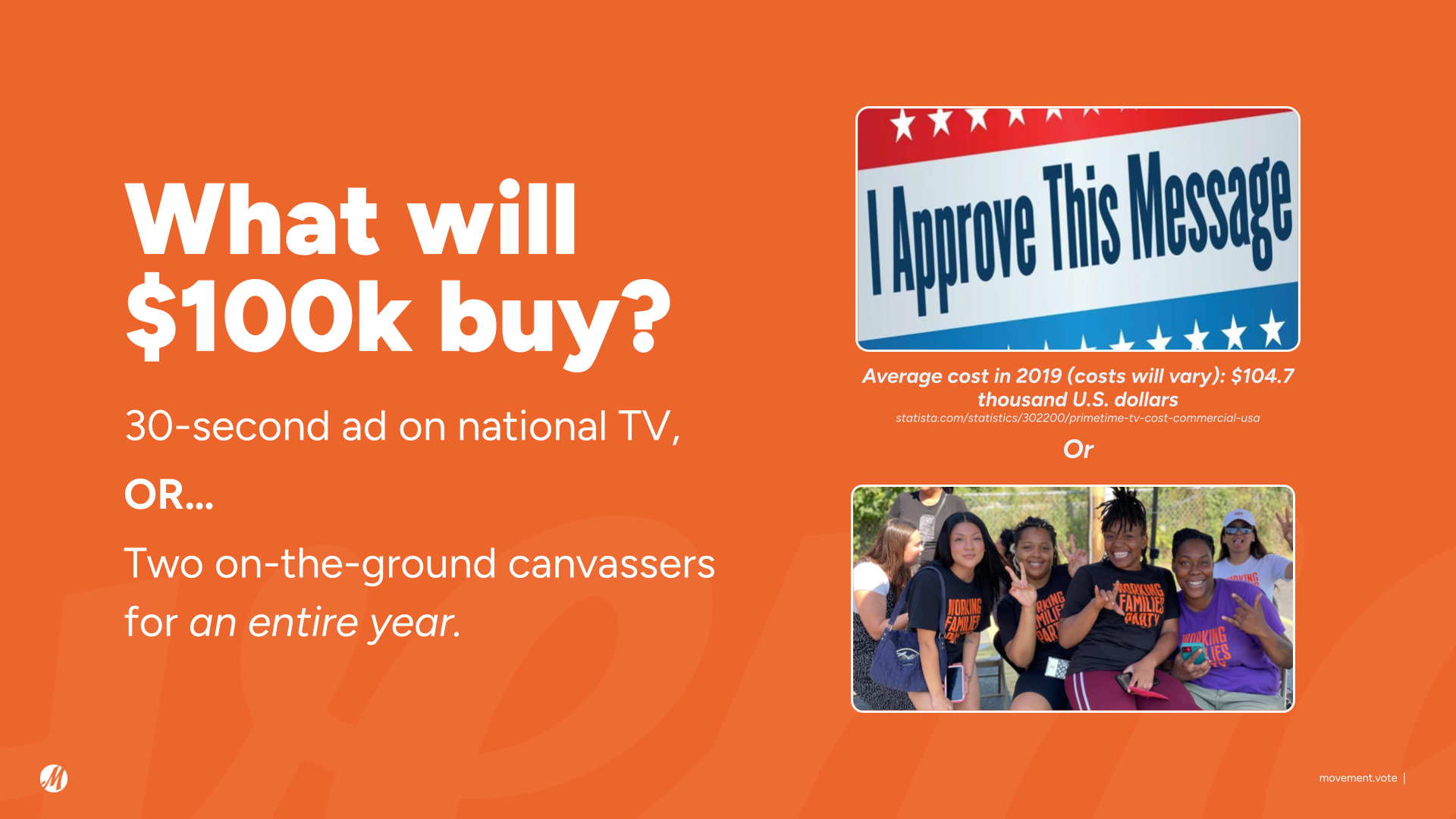
Candidate Cash Could Often Go Further Elsewhere
Sometimes, campaigns even raise so much money that they saturate the airwaves with ads and still are literally unable to spend it all before the election — leaving countless dollars inefficiently languishing instead of being sent to where they could have made up the margin of victory elsewhere. For more on this, check out these sobering reads at The New Republic and Open Secrets.
It’s About Who Votes, Not Who Runs
Blue Tent, the widely respected Democratic donor advising publication, makes this case eloquently in “The Problem with Giving to Political Candidates”:
“Elections are mainly decided by who’s voting, not who’s running — and thus, you’ll have the most impact by giving for organizing and GOTV work.
“[Political campaigns] are short-term operations that spend many of their resources on paid media and leave little behind. They’re not set up to engage deeply with people over time, which is how to change both political beliefs and civic behavior.”
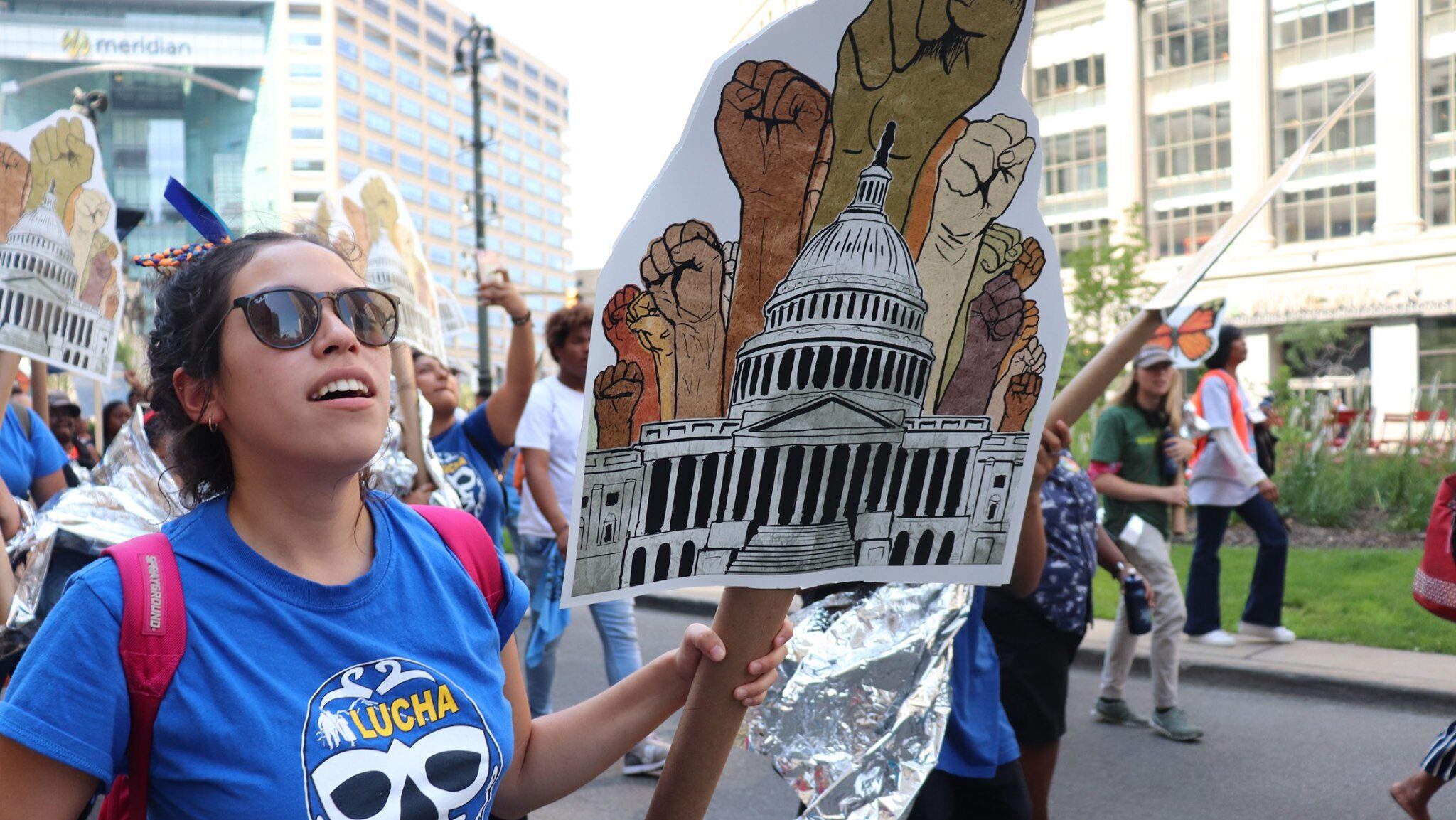
Living United for Change in Arizona (LUCHA)
Investments in local organizing go further.
- Local organizers know their neighbors, and research shows that “relational” outreach moves voters to action more effectively than ads, robocalls, and mailings.
- Local issues motivate voters to turn out when they might otherwise tune out.
- Local organizers build bottom-up power that grows year-round, year after year.
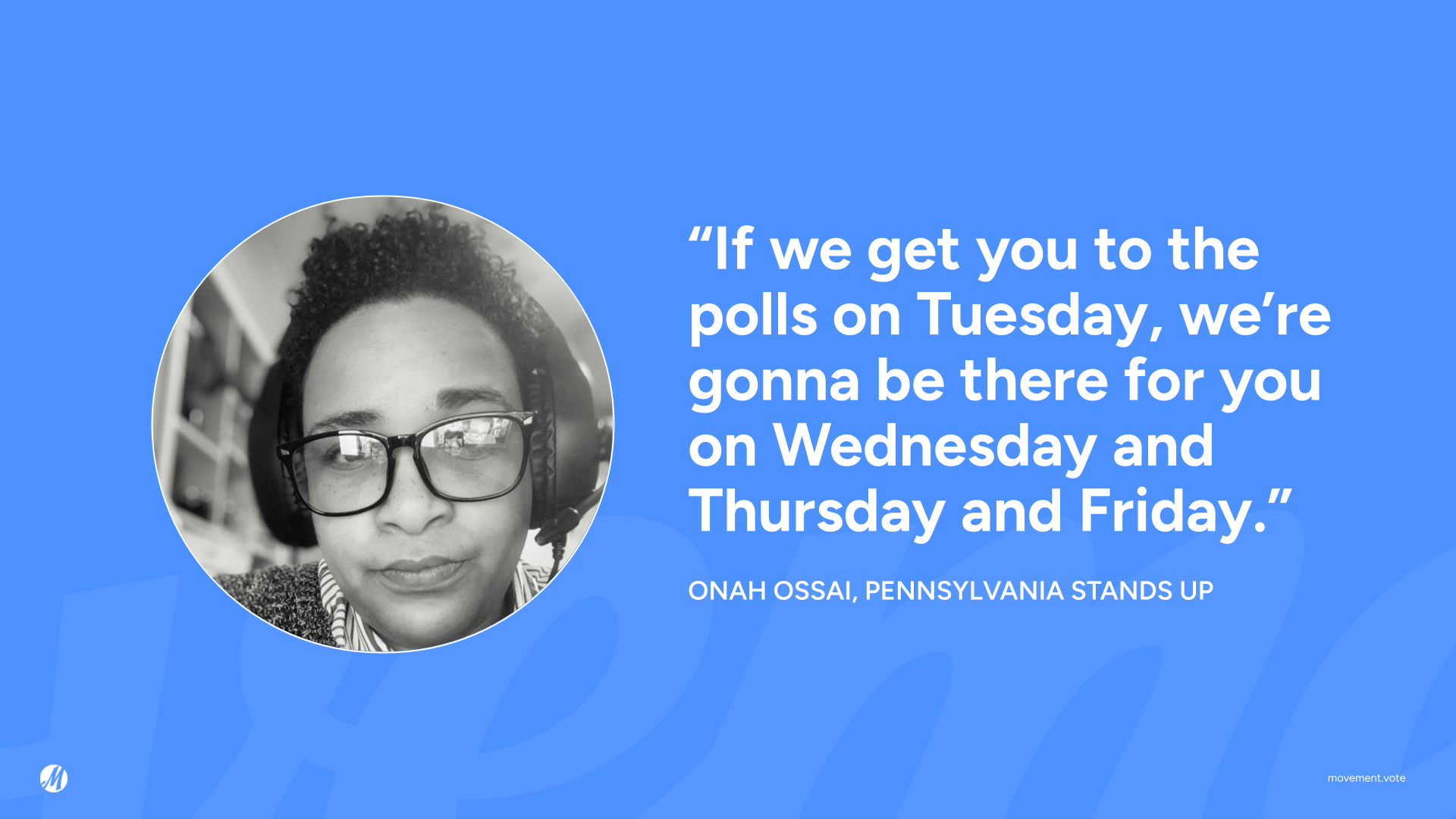
Part 3: Why Give Through MVP?
Who has time to research hundreds of elections and groups?
Think about this:
- There are hundreds of federal and down-ballot races in any given year.
- There are dozens of local organizations in any given state.
Who has the time (and expertise) to analyze trends, find the key races, research the best groups, and constantly recalibrate funding for maximum political impact?
Almost nobody.
This is where Movement Voter PAC comes in.
MVP is a one-stop shop for investing strategically in local organizations that win elections and transform policy. MVP:
- Does the research so you don’t have to.
- Maximizes your impact by investing in the best local voter engagement groups.
- Streamlines your giving, operating like a “mutual fund for political donations.”
There is an additional benefit to streamlined investing: You can hit “unsubscribe” on all the political spam clogging your inbox.
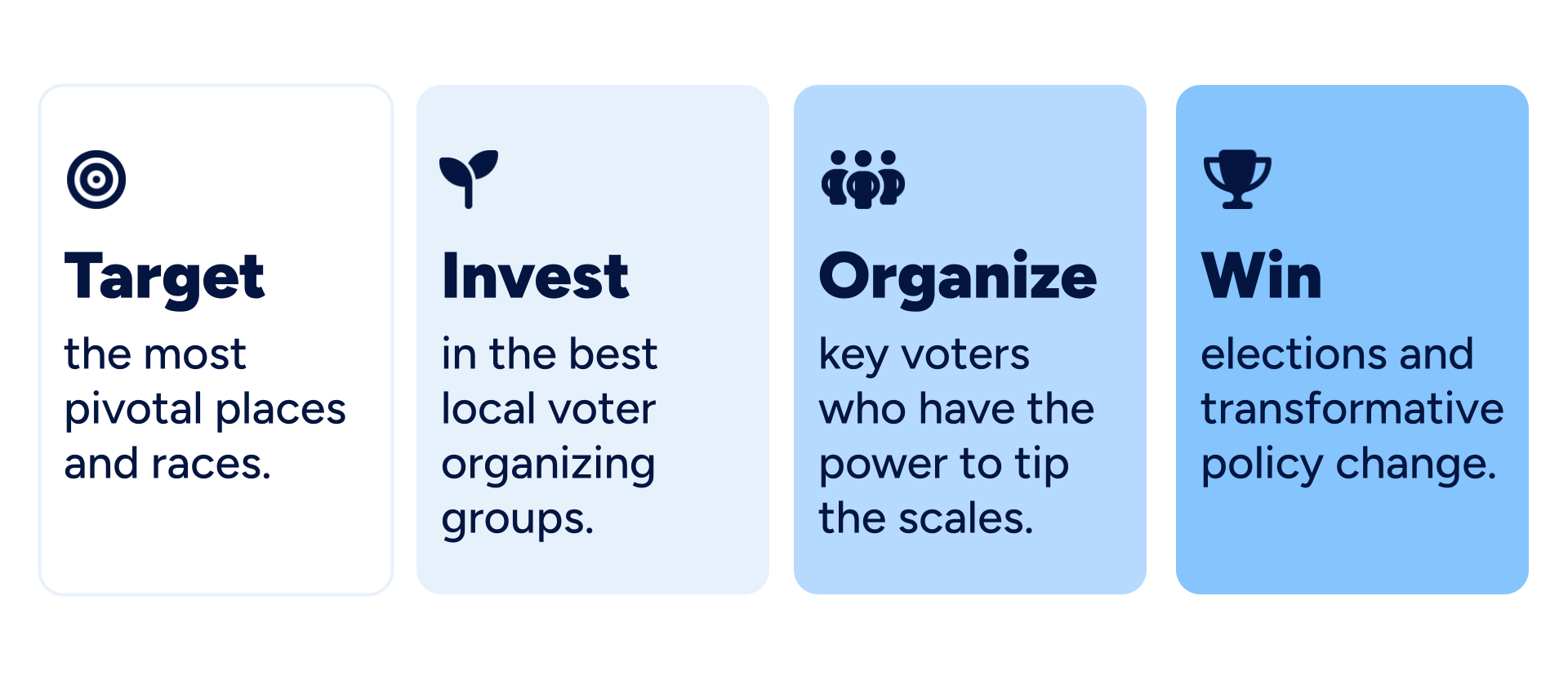
The MVP Model
Simply put, the MVP Model is to:
- Target the most pivotal places and races, both now and for the long term.
- Invest in year-round organizing and movement building, with a focus on youth, BIPOC, LGBTQ+, and immigrant voters.
- Organize key constituencies that can tip the scales and shift the culture.
- Win governing power and transformative policy change.
What makes MVP different?
1) On-the-Ground Expertise
Our grantmaking is led by a National and State Advising Team with years of expertise in organizing, social movements, and politics.
MVP State Advisors are not your traditional “program officers” making grants from behind a computer screen: They carry deep knowledge of the organizations we support, as well as the progressive “ecosystems” in which they operate. In most cases, our State Advisors have lived for years or decades in MVP’s highest-priority states.
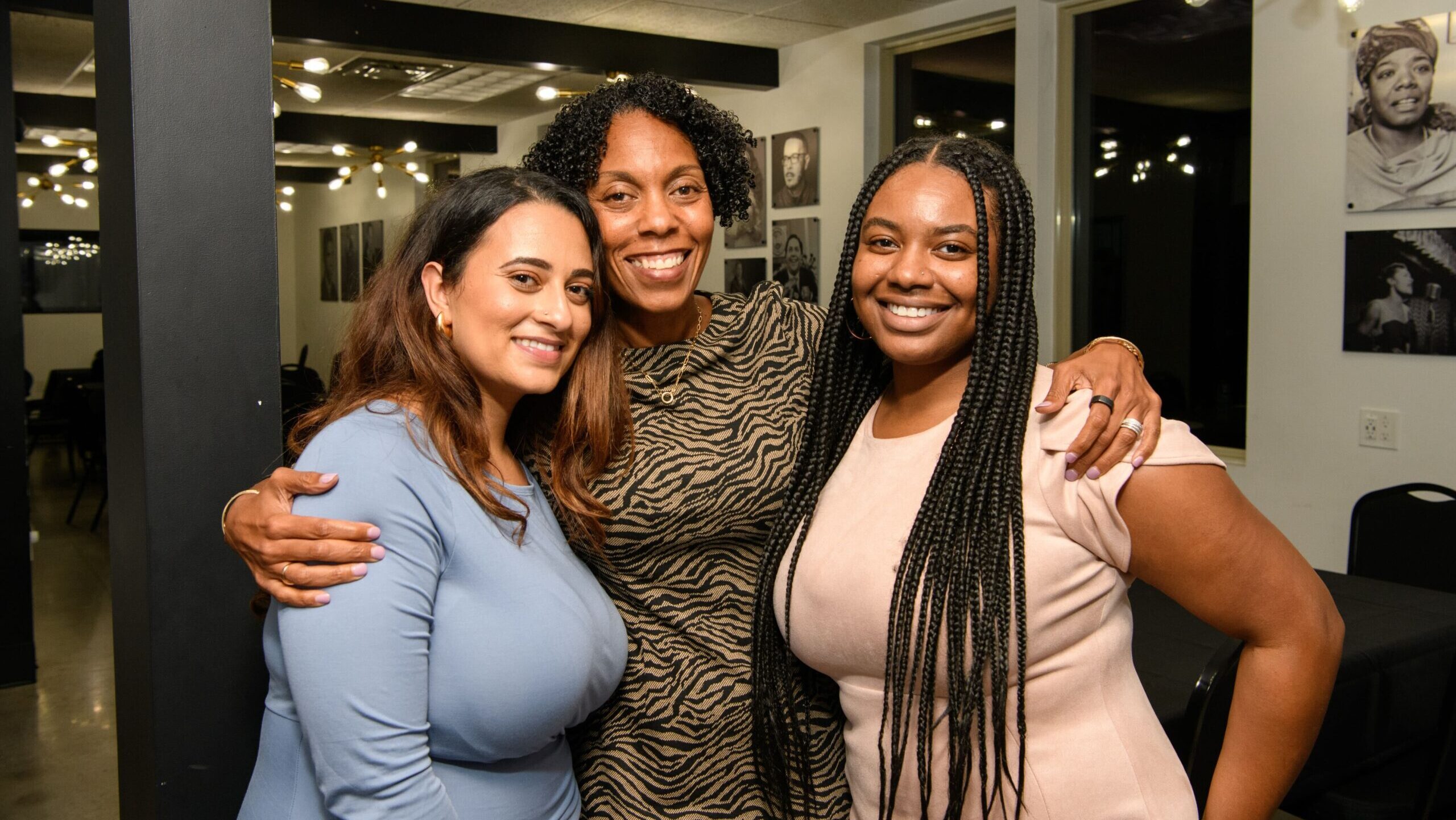
Left to right: Lela Ali, MVP Georgia Advisor; Zakiya Lord, MVP Regional Philanthropic Director; Jordan Brown, MVP Georgia Advisor
State Advisors operate based on local analysis, nuanced insights directly from our grantee partners, and a deep sense of solidarity with our local partners and the communities they serve.
As a result, MVP can identify and invest in some of the most high-leverage leaders, organizations, elections, and geographies that might have gone overlooked.
2) Builders, Not Just Funders
Our Capacity Building Program gives our partners the tools, skills, and support to strengthen, sustain, and scale their work.
Funding enables organizations to do their work. Capacity building lets them achieve more with the resources they have. When funders invest in both, we get more impact per dollar.
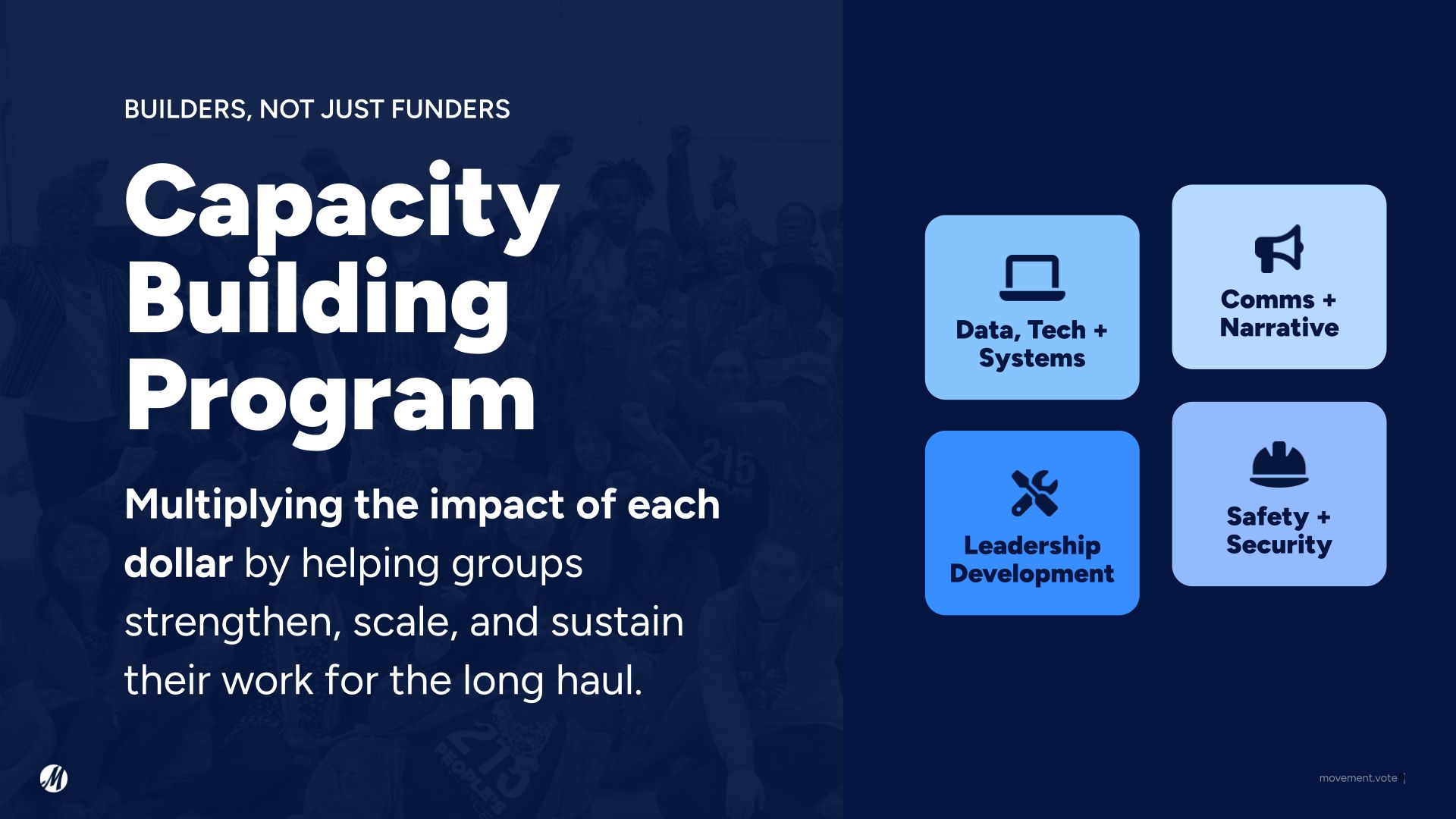
As a direct result of our local grantee partners’ requests, our Capacity Building Team provides access to tech tools (as well as gap grants to cover costs); consultant support from executive coaching to voter targeting; training and coaching; and crisis support to prevent and address political violence, hacking, infiltration, and more.
3) Long-Term State Power
Instead of just funding a few prominent groups per state, we invest in a diversified “ecosystem” of emerging, growing, and established groups working in key states to build lasting power.
To understand the value of this approach, consider this sports analogy:
“If you want to win the championship, you don’t just support a single player — you invest in the whole team.”
— Billy Wimsatt, Executive Director of Movement Voter PAC
MVP takes a “State Ecosystem” investment approach for two main reasons:
- Different approaches for different voters. To effectively organize young voters, BIPOC voters, LGBTQ+ voters, immigrant voters, rural voters, and more, we need to invest in local groups they know and trust. Organizations that are of, for, and led by each unique constituency can conduct micro-targeted outreach, share highly tailored communications, and deploy culturally relevant programs.
- The state ecosystem is greater than the sum of its parts. By leveraging shared analysis, shared strategy, and shared resources, MVP grantee partners are able to think bigger, tell a bigger story of what’s possible, take on more ambitious campaigns, and achieve more long-lasting political power.
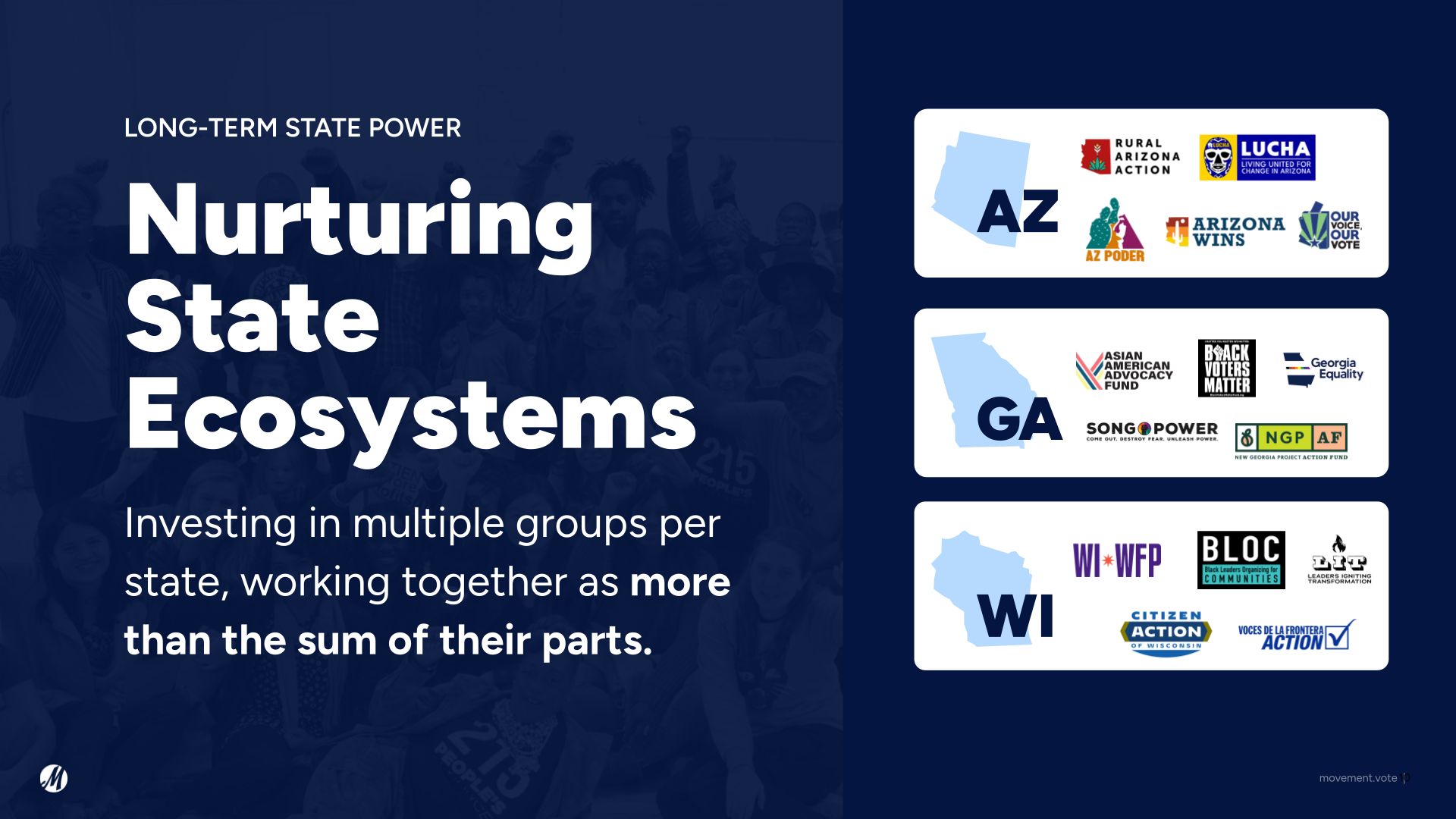
Through our “State Ecosystem” strategy, MVP:
- Gives seed funding to emerging groups who show great promise;
- Helps growing groups scale their operations;
- Ensures that established groups can sustain a prominent role in leveling up their state ecosystems.
Read how the “State Ecosystem” strategy made Minnesota a progressive stronghold »
4) “Triple-Bottom-Line” Investment Strategy
We invest in the people, places, and races key to a “triple bottom line”: Winning elections, building the power of underinvested communities, and creating transformative change.
Narrow metrics like “Cost Per Vote” (CPV) are designed to optimize for the efficiency of short-term voter turnout efforts, but they create profound inefficiencies for the progressive sector over the long term by leading funders to prioritize:
- High-propensity voters over more marginalized voting communities.
- Transactional quick-fix mobilization tactics over deeper organizing strategies.
- Short-term electoral outcomes at the cost of long-term power building.
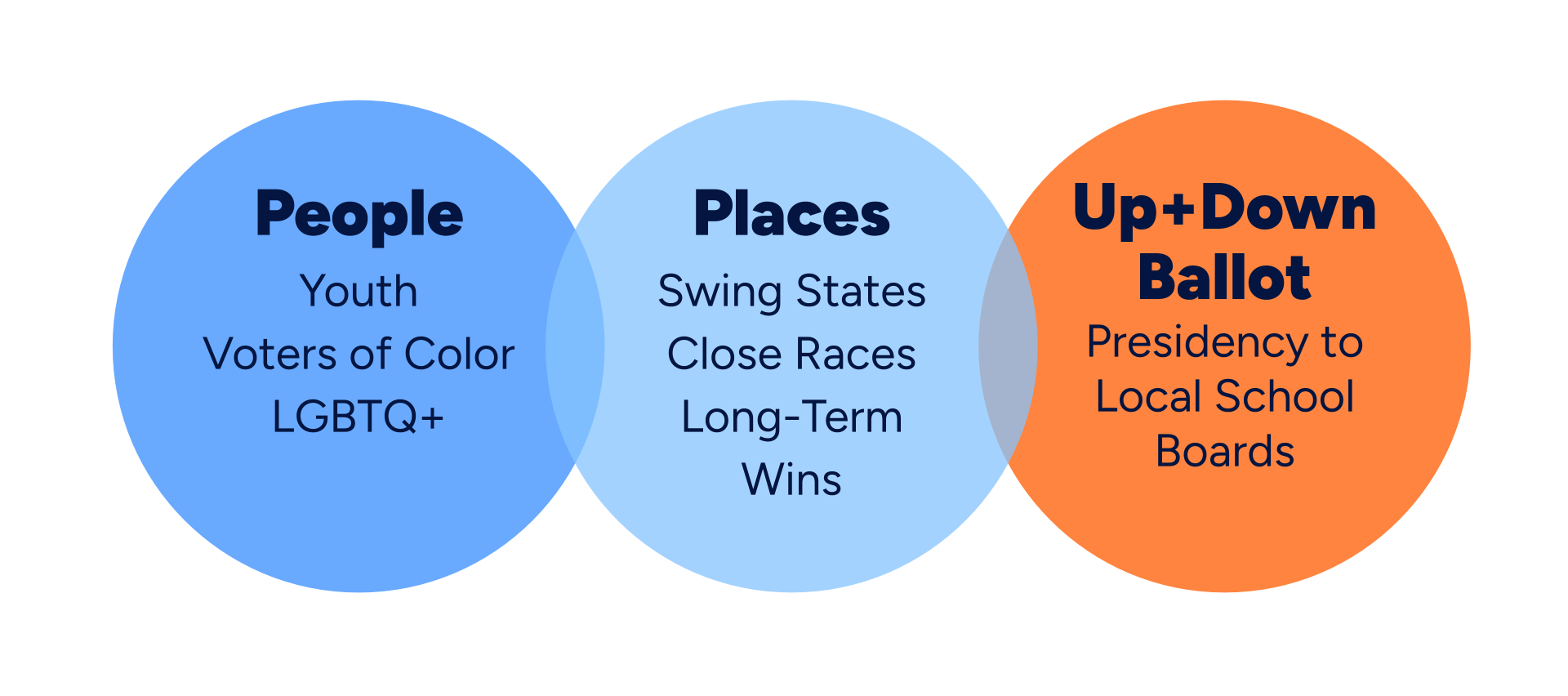
In line with our “triple-bottom-line” approach, we:
- Support the best and most promising local community-based organizations, with a focus on youth, communities of color, LGBTQ+ voters, and other communities that bear the brunt of injustice in the United States.
- Invest in groups that are not focused solely on electoral mobilization but also the kind of year-round advocacy, organizing, and power-building that is necessary to win durable majorities at every level of government.
- Take a deep and broad targeting strategy, investing in an expansive map of swing states, close races, and long-term wins up and down the ballot.
Deep and Broad Targeting
In our political targeting, we draw on in-depth political analysis and aggregated polling, coupled with insights from our regional and state advising teams. Each cycle, we weigh key races from the Presidency, US Senate seats, US House seats, state executive races, state chamber flip opportunities, local races, and ballot measure campaigns.
Targeting “Toss-Up” races is essential, but not enough. If we want to win elections now while growing long-lasting governing power, we need to invest in a wider electoral map.
“It is incredibly difficult to accurately predict which Congressional races will be the most competitive. In 2022, none of the top 10 races for outside spending were among the closest on election day.”
— Square One, “Power Brokers: An Analysis of Outside Democratic Spending in Close Congressional Races,” September 2023
We seek to play effective defense AND offense, by swinging “Toss-Up” races, fortifying vulnerable (“Lean and Likely” Democratic) races as an insurance policy, and expanding the electoral map to include “Lean and Likely” GOP races — to make immediate gains, and to ensure that in 5-10 years we are winning in places that today seem unthinkable.
5) Partnership, not Paternalism
We believe funders do the most good when we practice partnership, not paternalism or blind trust. To do this, we proactively collaborate with our grantees in a way that challenges them to think big, be strategic, and realize their potential. This means:
- Providing unrestricted funding so groups can bring flexibility, focus, and creativity to making the most impact instead of reductively rationalizing each budget line.
- Streamlining the grantmaking process by removing unneeded administrative burdens that would hinder our partners’ ability to actually do their jobs.
- Fostering honest communication and mutual accountability so that both MVP and our local partners can maximize learning, growth, and effectiveness.
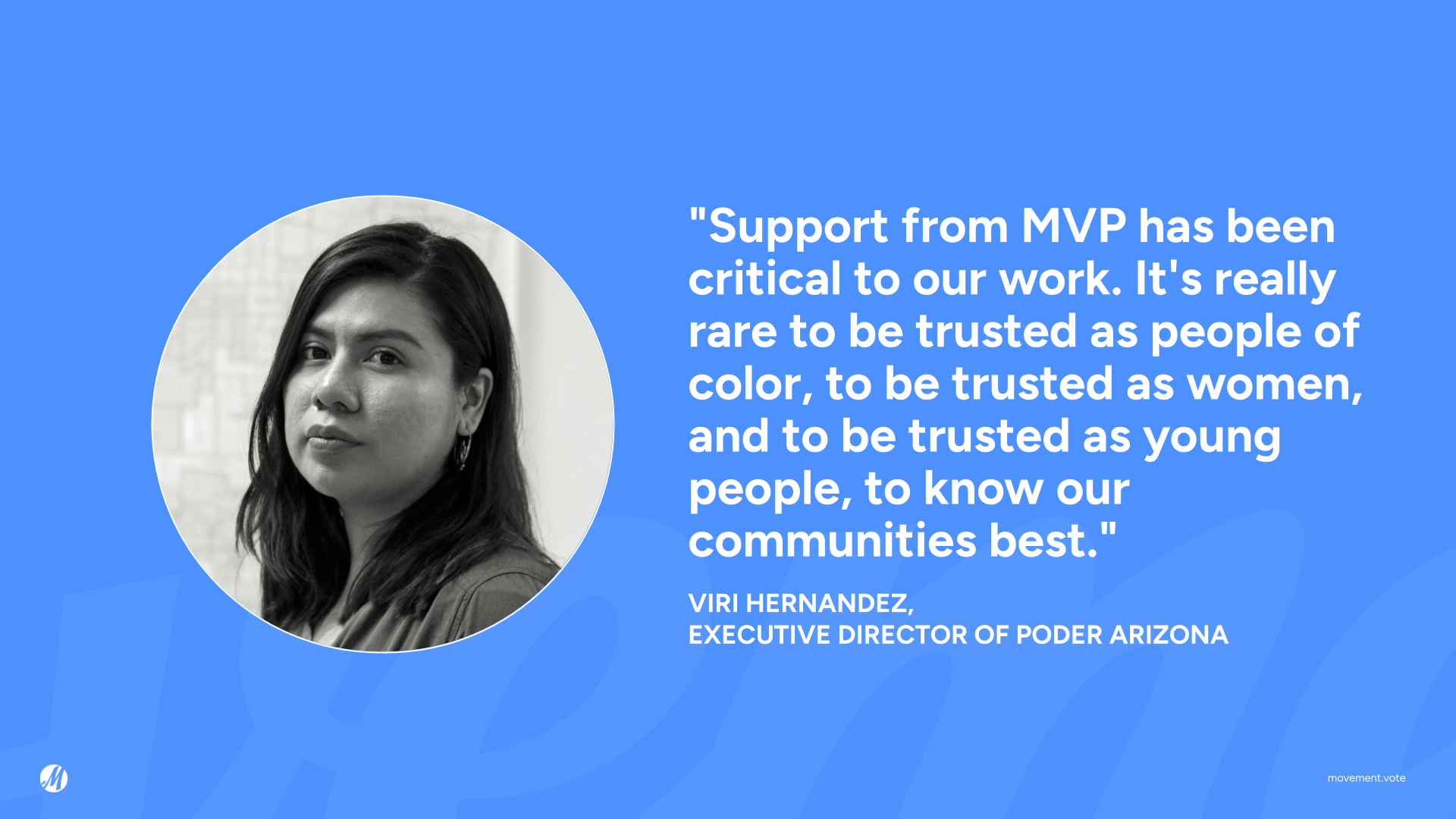
Bottom-Up Strategy, Long-Term Power
Instead of imposing policy positions and priorities from the top down, we support our partners in designing their agenda from the bottom up. By focusing on the issues people care about most, our partners give them a reason to vote — and to stay involved 365 days a year.
Rather than forcing groups into a prescribed set of strategies, we challenge and support them to pursue and to hone strategies tailored to their context.
6) Building a Movement of Donors
We are not just here to move money but to shift the culture of giving by building a movement of donors committed to funding deep, long-term organizing. Our donors are not just clients but also crucial partners in this work.
Each year, liberal donors give billions to traditional political campaigns — and hundreds of billions of dollars to charity. If we could redirect even a fraction of this to local organizing, we could transform the political landscape and solve so many societal problems “upstream.”
We believe the path to unlock this vast funding is to actively support and develop our donors into leaders and organizers who have the tools and support to bring their colleagues, allies, and networks into our work.
Learn more about the MVP Donor Organizing Program »
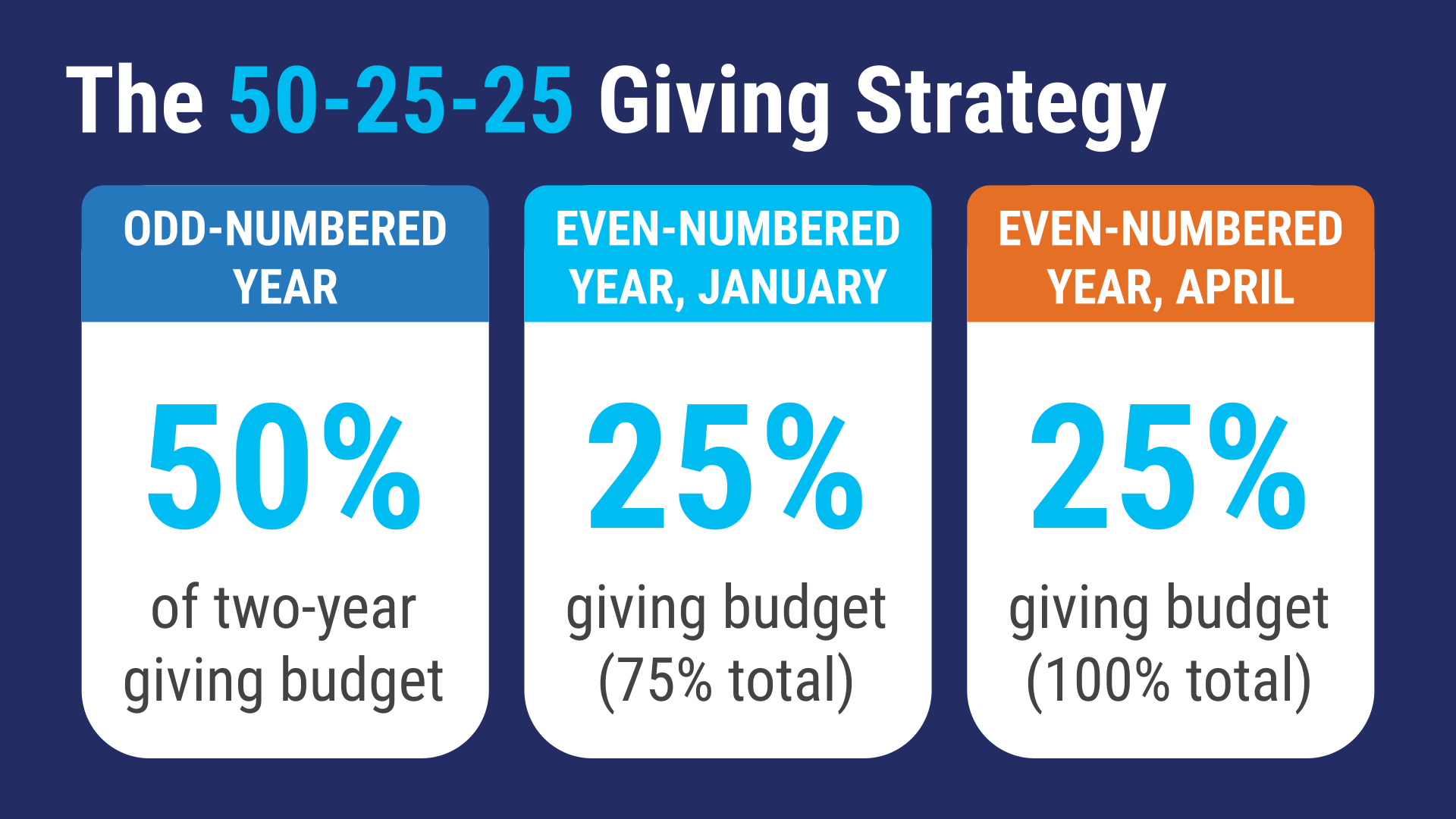
Part 4: How to Make Your Giving Plan
The 50-25-25 Strategy takes away the guesswork.
- Set a two-year giving budget. Dig deep. Identify the stretch you’d be proud to make.
- In odd-numbered years: Give 50% of your total budget as early as you can.
- In even-numbered years: Give 25% of your total budget in January, and the final 25% in April.
If every donor and funder were to take this approach, it would give organizations the financial certainty needed to operate strategically and produce their best results.
Finding your “No-Regret” Number
There are some traditional steps you should take, such as talking with your significant other and/or consulting with your financial planner.
In addition, we suggest that you:
- Start by asking yourself: “What amount would be a genuine stretch to give this year?”
- Now, imagine looking back at the end of the year, and knowing you absolutely gave all you could for the world you want to see.
- At this amount, would you regret not giving more? If “no,” great. If “yes,” consider giving more.
- Repeat until your answer is: “Yes! I’d end the year knowing I gave all I could.”
What’s Your Next Step?
Make a Donation
To build a multi-racial, intergenerational, cross-class movement powerful enough to transform the politics of our country, we also need to build a movement of donors to transform progressive political giving. We invite you to join us by making a donation.
We invite you to join us by making a donation.
Gifts Over $10,000:
Our team of professional donor advisors can help you align your unique interests with a disciplined strategy for winning elections and building long-term power.
View donation methods, contact your MVP Philanthropic Advisor, or email advisor@movement.vote to start crafting your giving plan.
Review the Evidence for the MVP Approach
A growing body of evidence supports the MVP approach. Here is a sampling.